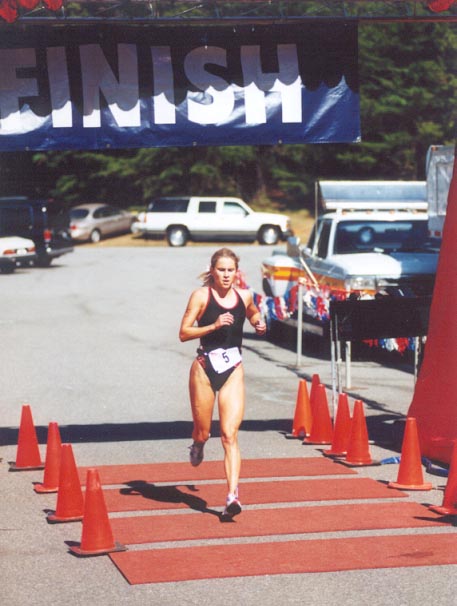|
HILL RUNNING MADE EASY
Hills don't have to hurt, and they don't have to be intimidating. There are techniques you can learn that will
make hill running a whole lot easier¬and I'm talking about up and down.
By shortening your stride and running with a light touch, you can feel nearly as good going uphill as you do on
flat land. With relaxed, controlled strides, you'll also be able to zoom down the other side without pounding your
legs.
Hills are great for teaching rhythm, one of the most overlooked and crucial aspects of distance running. If you
let hills break up your rhythm, you will slow dramatically. But if you make the proper adjustments to maintain
cadence, you'll make molehills out of the mountains you've been climbing.
This topic makes me think of when I ran the Marine Corps Marathon with a friend in 1995. "I don't have the
leg strength to run hills well," Marlene blurted out to me as we crested Capitol Hill. "I don't care
what you say about stride length, I lose it on the uphills." I offered suggestions as best I could . . . and
remembered the days when I struggled with hills.
Early enlightenment
As a collegiate cross-country runner¬and full of hill-running bravado¬I would pass runners by the dozens
on uphills, only to be repassed by the end of the race. Then, during my senior year at Wesleyan University, I got
injured. Coach Swanson insisted that I ride the course with him in the team van.
From my window, I watched as teammate Amby Burfoot patiently let brasher runners move ahead on the hills early
in the race. Most of them ended up paying for it (as I had) by using up valuable energy. Amby cruised easily on
the uphills, then took advantage of downhills with relaxed, controlled striding. Later, as the others struggled
with late-race fatigue, he still had something left for a strong finish. Watching that race began my evolution
into a good hill runner, and I have since learned many more lessons on smoothing out the ups and downs. Here are
some for you now.
Heavy breathing
Whether you're going up or down, try to maintain the same level of effort and QUICK TIP:
We Are the Champions: Approach running like a champion. Actively create a life of balance, moderation, and simplicity--values
that help improve running and life.
You'll find more health, training, & motivational tips in every issue of RUNNER'S WORLD.
breathing rate that you use on level ground. Don't worry if you're slowing down going up, just reduce stride length
accordingly. Continue to shorten your stride when the grade is steeper, and extend to normal as the grade eases,
all the while maintaining steady effort and breathing.
It's a wonderful revelation when you realize there's a stride short enough to give you control over the steepest
of hills. As you shorten your stride and keep your feet directly under your body, you'll gain efficiency and competence.
With competence comes confidence.
Up we go . . .
Here's exactly how hill running should work. As you start uphill, shorten your stride. Don't try to maintain the
same pace you were running on the flat. This will exhaust you and leave you depleted later, when you can least
afford it. Take "baby steps" if necessary, and try to keep the same turnover rhythm as on the flat. Your
posture should be upright (don't lean forward or back); head, shoulders and hips should form a straight line over
the feet. Keep your feet low to the ground. If your breathing begins to quicken, this means you're either going
too fast, overstriding or bounding too far off the ground.
You should use a light, "ankle-flicking" push-off with each step, not an explosive motion. (This wastes
energy.) If the hill is long or the grade increases, keep shortening your stride to maintain a smooth and efficient
breathing pattern. Run "through" the top of the hill. That is, don't crest the hill and immediately slow
down or pull back on your effort. Rather, accelerate gradually into the downhill. Gravity is now on your side.
. . . and down again
As you head downhill, stay relaxed. As with uphills, don't overstride. (You don't want to catch too much "air.")
Overstriding pounds the feet, stresses the hamstrings and overuses the quadriceps muscles at each footfall. Keeping
feet lower to the ground will give you more control. Because you're going downhill, your stride will cover more
ground than it does on flat land, though it should feel slightly shorter.
Touch lightly with each step and let the steepness of the hill dictate your stride rate. If you start going too
fast, shorten your stride slightly until it is under control. On gentle downgrades, you might want to try leaning
forward slightly to increase speed. Just be careful; leaning too much may chop your stride or make you go too fast.
Lastly, visualize gravity pulling you downhill. The momentum you gain going downhill is a wonderful source of energy
as you move to level terrain or to another hill.
All together now
So, here's what you need to remember: On the uphills, reduce your stride length but maintain the same stride rhythm
and breathing rate. On the downhills, increase stride rhythm somewhat (in response to the downslope) but don't
overstride. Keep feet low to the ground.
A medal for Marlene
Marlene recovered after Capitol Hill but then struggled badly on the deceptively long and steep climb to the Iwo
Jima monument at the finish of the Marine Corps Marathon. She seemed to be resisting my words of encouragement
until I hit on the right phrase: "baby steps." Suddenly, she shortened her stride and shifted her feet
underneath her. Her breathing rate decreased, yet she was able to maintain speed. She was running easier . . .
and there was a smile on her face.
Troubleshooting the Hills
Check the following to see where you need help and what to do about it.
Going Up Going Down
Problem Cause Problem Cause
Breathing too rapidly Overstriding, or bounding too high Tight hamstrings, sore shins or "flapping" feet
Overstriding; too much "air"
Tight leg muscles Overstriding Arms flailing; loss of rhythm Going too fast
Tight or sore lower back Leaning too far forward Sore lower back Leaning too far backward
Shoulders and arms tired or sore Too much arm-swing, or arms extended too far forward Sore quadriceps muscles Probably
over-striding, thus forcing quads to work too hard
Jeff Galloway, member of the U.S. Olympic team at 10,000 meters, 1972. A graduate of Wesleyan University. To learn
more, www.jeffgalloway.com is your stop for the latest running and fitness information from Jeff Galloway!
Copyright 1999 RODALE PRESS, INC. All rights reserved. The information contained in the preceding story may not
be published, broadcast or otherwise distributed without the prior written authority of Rodale, Inc., Emmaus, PA
18098; (610) 967-8809.
|
|
|

